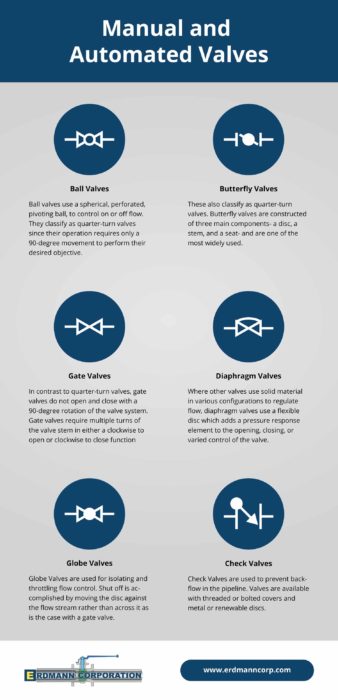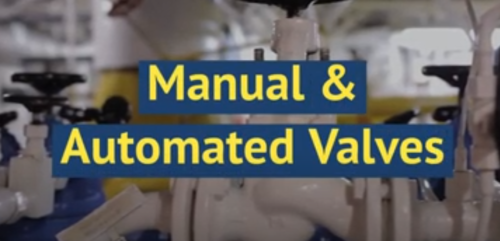A valve is a mechanical device used to start, stop, and regulate the flow of liquids, gases, gels, powders, and other substrates by opening, shutting or partially obstructing one or more of the passageways in a piping system by way of a disc, ball or plug. This can be accomplished either manually or automatically through actuation.
Manual actuation of a valve involves direct, physical contact with its hand wheel, lever or gear operator, while power automated actuation utilizes air pressure, electricity, or hydraulic pressure controlled by flow conditions, monitoring systems, or other means that does not involve physical contact with the valve. Valve actuators may open and close valves or allow for throttling of the valve. Some valve actuators include switches or other ways to remotely indicate the position of the valve opening.
Materials of construction for valves are cast iron, carbon steel, stainless steel, chrome alloys brass, bronze, hastelloy, inconel, monel, titanium, alloy 20 and PVC among others.
End connections of valves are flanged, butt weld, threaded, socket weld, lug and wafer.
Every piping system has unique features that perform according to the purpose of its design. Understanding the five common types of valves, how they work, and their different configurations will help you select the right option for your system.
Ball Valves
Ball valves use a spherical, perforated, pivoting ball, to control on or off flow. They classify as quarter-turn valves since their operation requires only a 90-degree movement to perform their objective. The ball it uses has a hole bored through it to accommodate flow. The diameter of this hole matches the inside diameter (I.D.) of the installed pipe, allowing flow through the ball when the valve is open and closed when it is pivoted 90 degrees by the valve lever. Ball valves perform well after many cycles closing securely after long periods in one position. These qualities make them an excellent choice for shut off and control applications. There are many different seats and seals that are used in ball valves based on their service, pressure and temperature. Seat and seal materials include virgin teflon, TFM, reinforced teflon, peek, nylon, delrin, Kel F, graphite, 50-50 and metal.
Configuration Types
There are several types of ball valves, distinguished by their design:
- Split Body
- Single Body
- Three-Piece Body
- Top Entry
- Trunnion
- Floating
Ball valves are also classified according to their shape and function, such as:
- Full-Port
- Reduced-Port
- V-Port
- Cavity Filler
- Multiport
- Sanitary
Applications
Common applications of ball valves include gas processing, transmission, storage tanks, steam, high pressure, high temperature, air, liquid and other fluid applications.
Butterfly Valves
These also classify as quarter-turn valves. Butterfly valves are constructed of three main components—a disc, a stem, and a seat—and are one of the most widely used. Their simple design allows for shutting off flow by rotating the stem 90 degrees until the disc contacts the seat and completes a seal. When opened, the media flows past the disc on either side.
Configuration Types
There are two configuration types for butterfly valves, related to the location of the stem’s connection to the disc. In centric designs, the stem passes through the center of the disc, creating equal flow on either side when the valve is open. Eccentric designs include one or more stub-shafts offset from the center of the disc. Further distinctions of eccentric butterfly valves include single, double, and triple offset valves in relation to the number of stub-shafts included in their design. Typical seat and seal materials include teflon, reinforced teflon, EPDM, buna and metal among others.
Applications
Butterfly valves are common in water supply, wastewater treatment, fire protection, gas supply, chemical and oil industries, fuel handling systems, and power generation.
Gate Valves
In contrast to quarter-turn valves, gate valves do not open and close with a 90-degree rotation of the valve stem. Gate valves require multiple turns of the valve stem in either a clockwise to open (CTO) or clockwise to close (CTC) function. The turning of the valve stem raises the valve disc to open or lower it in order to close it. Gate valves are for on/off control only and should only be used fully opened or fully closed.
Configuration Types
Gate valves include the broadest range of configuration types, distinguished by the type of gate, the way they rise on the stem, and their seating configuration. Some examples include:
- Parallel slide
- Wedge
- Pressure seal
- Knife
- Rising stem
- Non-rising stem
- With warm up bypass
- Bolted bonnet
- Welded bonnet
- Outside screw and yoke
Applications
Gate valves are common in situations where pressure loss and free bore is among the required features, and they help to prevent damage from water hammering because they open slowly. Industrial uses of these valves include potable water, wastewater, irrigation, and gas and oil.
Diaphragm Valves
Where other valves use solid material (plug, disc, or ball) in various configurations to regulate flow, diaphragm valves use a flexible, or elastomeric, disc, which adds a pressure response element to the opening, closing, or varied control of the valve. This is a linear motion valve, actuated by pushing the diaphragm into the seat in the bottom of the valve to shut off flow or lift it to allow the flow to pass beneath.
Configuration Types
Variations in diaphragm valves relate to the different materials (butyl, teflon, EPDM, neoprene, etc.) used to make the disc, as well as connection types like threaded, compression fitted, bolt flange, clamp flange, and butt weld. They can also be plastic, rubber or glass lined.
Applications
These have minimal contact surfaces, making them the cleanest type of valve used in applications in the pharmaceutical, food processing, and water treatment industries, as well as electronics, pulp and paper, power, and high-purity water industries.
Globe Valves
Globe Valves are used for isolating and throttling flow control. Shut off is accomplished by moving the disc against the flow stream rather than across it as is the case with a gate valve. This reduces vibration, wear and abrasion. The flow pattern through a globe valve involves changes in direction, resulting a greater resistance than that in a gate valve. Valves must be installed in proper relation to media flow as indicated by a flow direction arrow on the body. These valves are available in bolted, pressure seal, welded and screwed bonnet designs.
Configuration Types
Globe valves are available with three basic types of discs: metal plug, renewable disc, and V-port. They are also available in 90 degree angle pattern and with the stem positioned in a 90 degree or 45 degree Y pattern angle to the valve.
Applications
This valve is used in boiler vents, drains; main steam vents, drains; turbine lube oil systems, seals, drains; feed water, chemical feed, fuel oil and cooling water systems.
Check Valves
Check Valves are used to prevent backflow in the pipeline. Flow is in a straight line through the valve resulting in minimum pressure drop. The disc swings or lifts into open position as media flows through the valve. Back pressure in the pipeline and/or gravity holds the disc in position. Check valves are installed in horizontal or vertical pipelines, but must be installed in proper relation to media flow as indicated by the flow direction arrow on the body. Valves are available with threaded or bolted covers and metal or renewable discs.
Configuration Types
Check valves are available in swing, piston, ball, silent, dual disc, spring loaded and stop designs.
Applications
Check valves are used in many fluid systems of chemical, industrial and power plants.
Contact Us for Our Wide Selection of Manual & Automation Valves
Erdmann Corporation is a premier distributor of valves and automation for all industrial applications. Our services include manual valve and valve actuation expertise with an array of superior quality and high-tech products to meet the needs of our customers. Our knowledgeable and professional team with over 200 years of combined experience is driven to provide top-notch service with timely and accurate responses for each client’s specification.
Contact us to learn more about the manual and automation valve solutions we can provide to your organization or request a quote from one of our service oriented experts.



